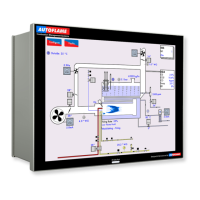4 Top Blowdown
Page 78 Mk8 MM Expansion Features Installation and Set-Up Guide 04.09.2016
4.4 Ways of Controlling TDS Level
4.4.1 Continuous TDS Control
1. The first stage of the TDS control cycle is the sample time where the valve is fully opened to take a
fresh sample for a time period set in expansion option 48.
2. After a fresh sample has been taken and the sample time elapsed, the second stage is the settle
time. In the settle time, the valve fully closes to let the sample settle, for a time period set in
expansion option 49.
3. Once the settle time is over, the valve will remain closed for another time period called
measurement time, set in expansion option 50. The TDS probe will measure this sample and this is
the reading in the TDS control.
4. If the measured value is less than the target value set in expansion option 42 minus 100ppm, the
valve will not blowdown, and remain fully closed for the blowdown. For example, if the target TDS
value was set as 2200pppm, the measured value was 2099ppm or less the valve would not
blowdown. At the end of the blowdown time, the cycle will repeat and the TDS control will
progress to the sample time.
5. If after the settle time the measured value is above the TDS target value minus 100ppm, the valve
will drive open to a position determined by the PI loop to blowdown the valve and try to maintain
the TDS target value. For example, if the target value was set to 2200ppm, the measured value
would need to be 2100ppm or more for the valve to blowdown. At the end of the blowdown time
set in expansion option 51, the valve will go to fully open for the sample time, to repeat the TDS
control loop.
4.4.2 Solenoid and Servomotor 2-State TDS Control
1. The first stage of the TDS control cycle is the sample time where the valve is fully opened to take a
fresh sample for a time period set in expansion option 48.
2. After a fresh sample has been taken and the sample time elapsed, the second stage is the settle
time. In the settle time, the valve fully closes to let the sample settle, for a time period set in
expansion option 49.
3. Once the settle time is over, the valve will remain closed for another time period called
measurement time, set in expansion option 50. The TDS probe will measure this sample and this is
the reading in the TDS control.
4. If the measured value is less than the target value set in expansion option 42 minus 100ppm, the
valve will not blowdown, and remain fully closed for the blowdown. For example, if the target TDS
value was set as 2200pppm, the measured value was 2099ppm or less the valve would not
blowdown. At the end of the blowdown time, the cycle will repeat and the TDS control will
progress to the sample time.
5. If after the settle time the measured value is above the TDS target value minus 100ppm, the valve
will remain fully open for part of the blowdown time; this fully open interval is determined by the P
element, and then the valve will go to fully closed for the remainder of the blowdown time. For
example, if the target value was set to 2200ppm, the measured value would need to be 2100ppm
or more for the valve to blowdown. At the end of the blowdown time, the valve will go to fully
open for the sample time, to repeat the TDS control loop.

